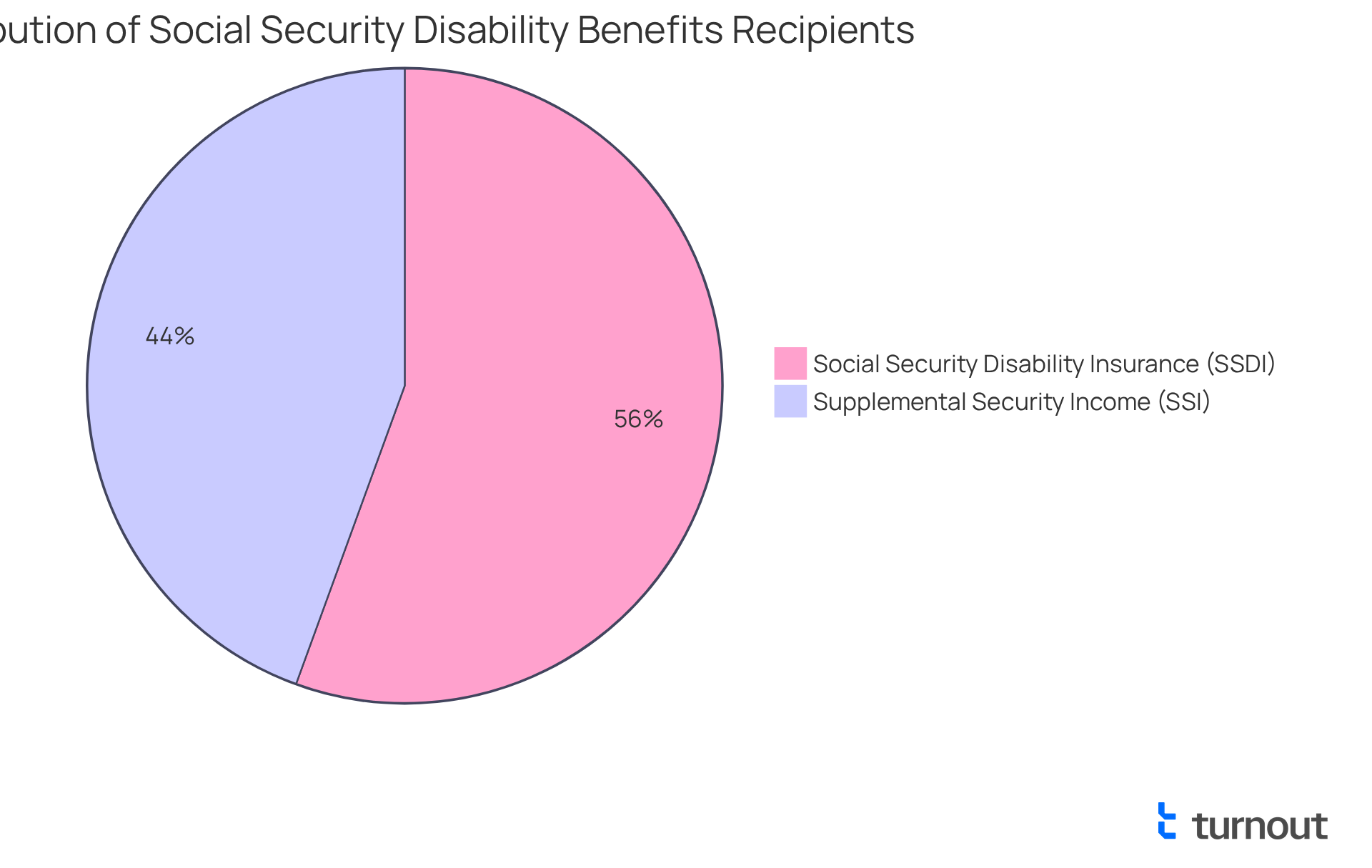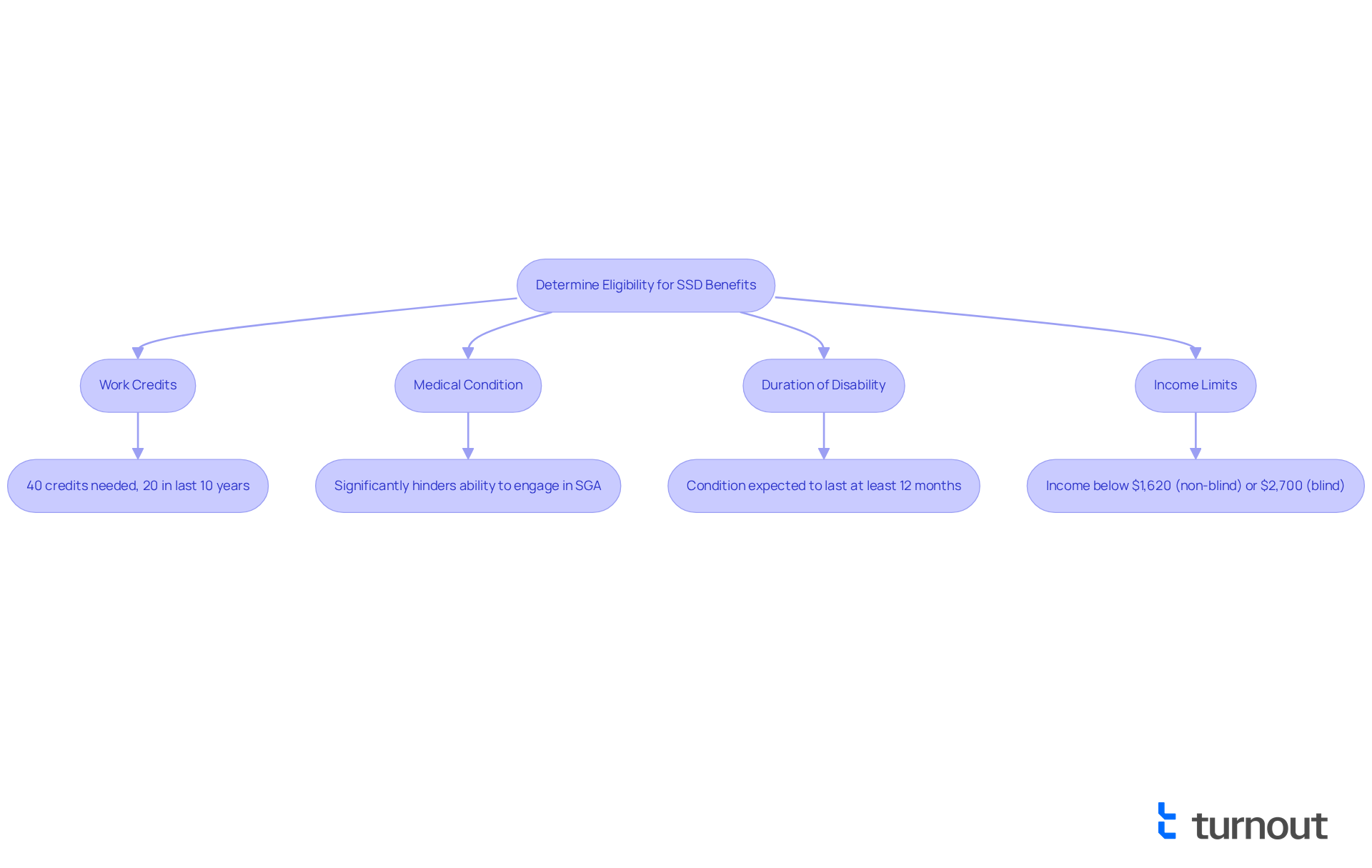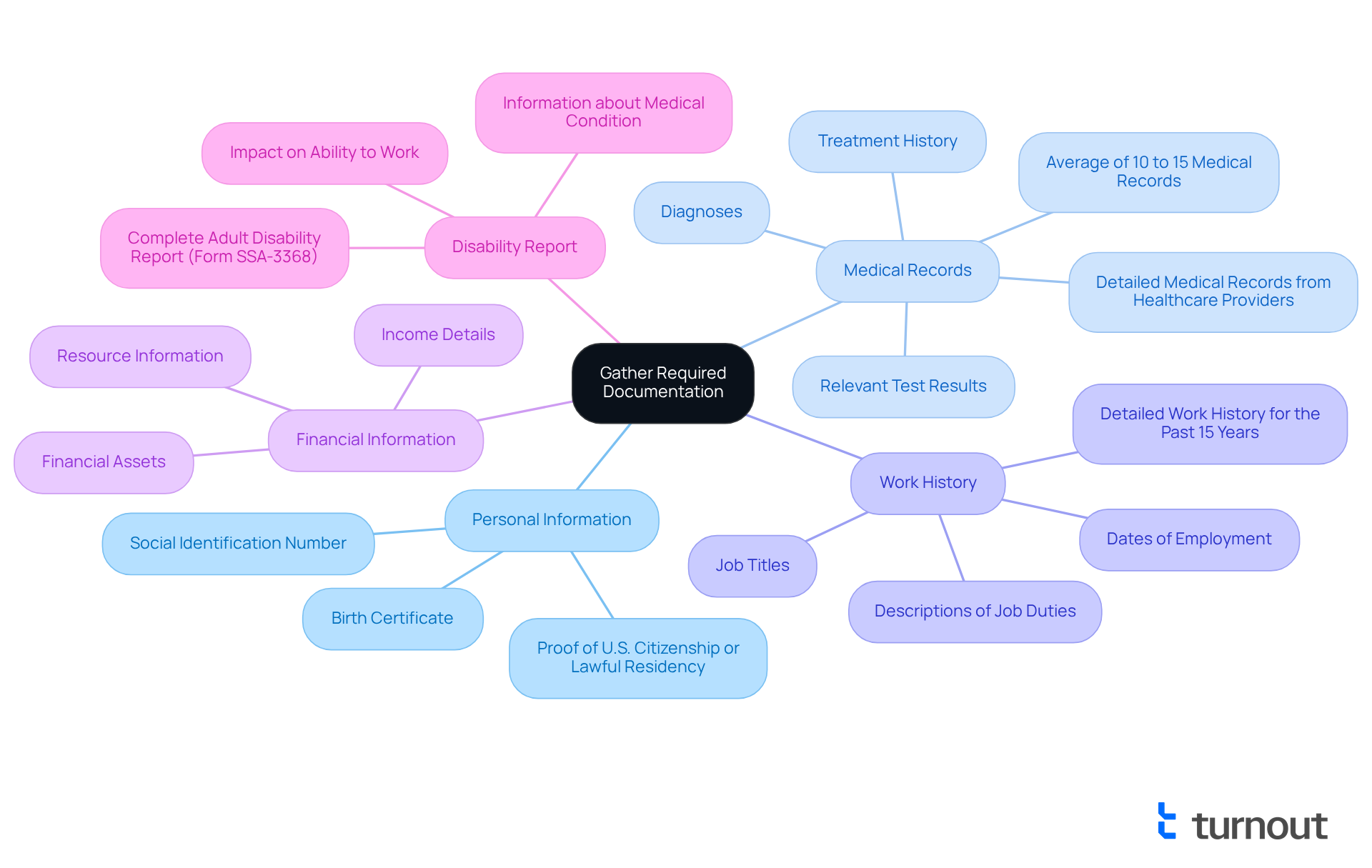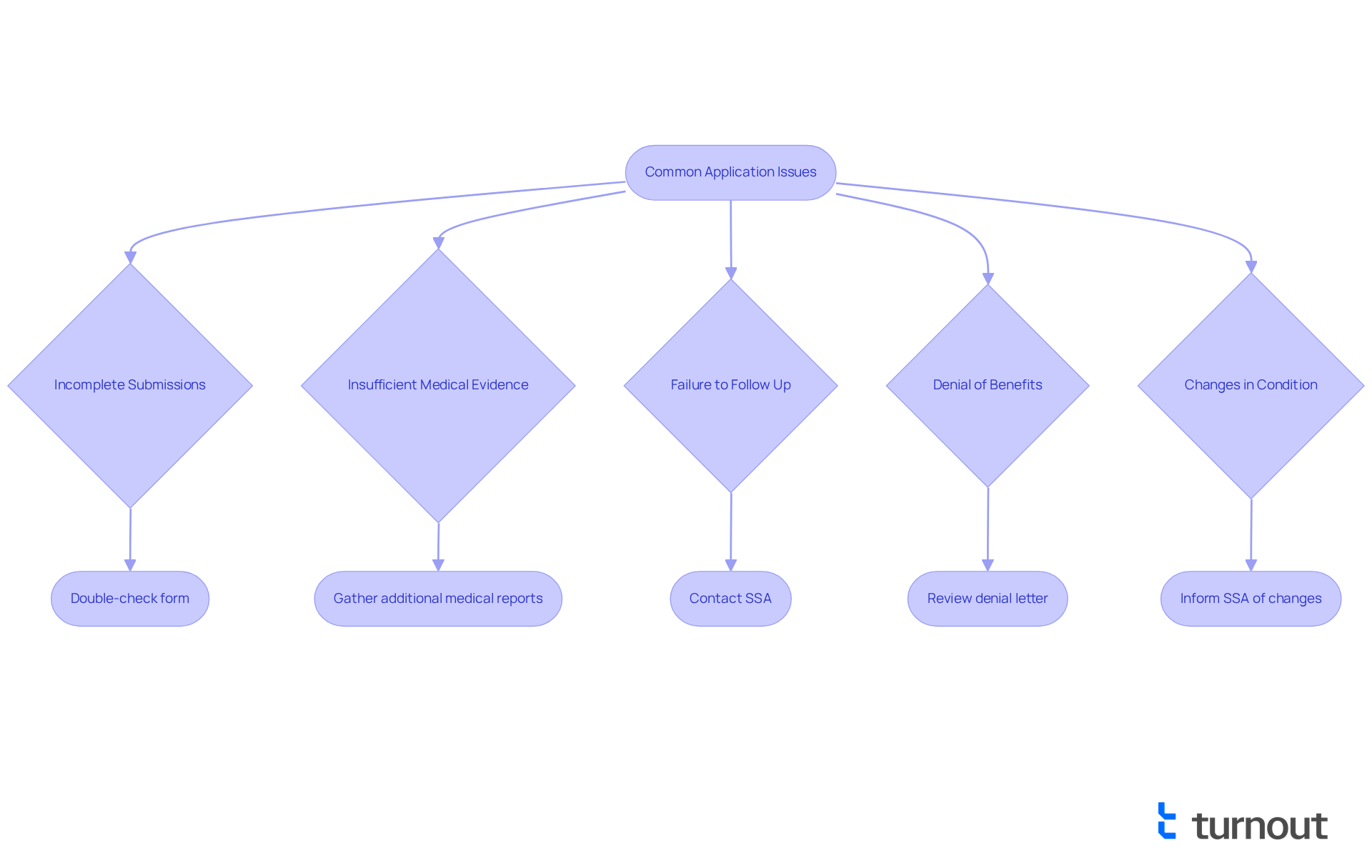Overview
Navigating the path to secure Social Security Disability benefits can feel overwhelming. We understand that many individuals face challenges in this process. The article outlines five essential steps to help you through this journey:
- Understanding eligibility requirements
- Gathering necessary documentation
- Completing the application process
- Troubleshooting common issues
Each step is designed to support you in improving your chances of a successful application.
These steps are backed by detailed explanations of the different types of benefits available. It's crucial to recognize the importance of thorough documentation. Remember, proactive follow-up strategies can make a significant difference in your application experience. You're not alone in this journey; we’re here to help you every step of the way.
Introduction
Navigating the complexities of Social Security Disability benefits can feel overwhelming, especially for those grappling with long-term medical conditions. We understand that millions depend on these essential financial supports, making it crucial to grasp the differences between programs like Social Security Disability Insurance (SSDI) and Supplemental Security Income (SSI). This understanding is vital for securing the assistance you need.
However, the path to obtaining these benefits is often filled with challenges. What steps can you take to enhance your chances of a successful application and avoid common pitfalls? You're not alone in this journey, and there are ways to navigate it more effectively.
Understand Social Security Disability Benefits
Social Security benefits disability offer crucial financial support for those unable to work due to a medical condition that is expected to last at least one year or result in death. The two primary programs available are Social Insurance Disability Assistance and Supplemental Income. It's important to understand that social security benefits disability depend on your employment history and contributions to Social Security, while Supplemental Security Income is based on need and does not require prior work experience. Recognizing these differences is essential, as they directly impact eligibility and benefit amounts.
As of July 2025, around 10 million individuals are receiving Social Security Disability Insurance benefits, while approximately 8 million rely on SSI. This distinction highlights the varying requirements of beneficiaries, with Social Security benefits disability insurance catering to those with a work history and Supplemental Security Income supporting low-income individuals, including those with disabilities.
To navigate these programs effectively, we encourage you to start by exploring the Social Security Administration (SSA) website. It provides a wealth of resources on benefits, eligibility criteria, and submission methods. Familiarizing yourself with the differences between SSDI and SSI will empower you to identify the most suitable program for your circumstances related to social security benefits disability.
We understand that the enrollment process can be complex and time-consuming, often requiring detailed medical documentation and personal information. Being well-prepared and informed can significantly enhance your chances of a successful application. Financial advisors emphasize the importance of understanding these programs, noting that "knowing your rights and securing proper representation can make a substantial difference in the outcome of your application."
In 2025, social security benefits disability are expected to increase by 2.5% due to the cost-of-living adjustment (COLA), while SSI recipients will see their highest monthly payment rise from $943 to $967. Additionally, potential changes to the eligibility standards and benefit assessments for social security benefits disability may affect current and future recipients. Ongoing efforts to streamline the claims process aim to reduce delays and backlogs. It's crucial to stay informed about any changes that may impact your benefits, as you're not alone in this journey.

Determine Your Eligibility for Benefits
If you're exploring your eligibility for Social Security Disability Benefits, it's important to consider several key factors that can impact your journey:
-
Work Credits: Typically, you will need 40 work credits to qualify for SSDI, with at least 20 earned in the last 10 years. However, we understand that younger individuals may face different circumstances; those under 24 can qualify with fewer credits, reflecting the program's flexibility to support younger applicants.
-
Medical Condition: Your disability must significantly hinder your ability to engage in any substantial gainful activity (SGA). The Social Security Administration (SSA) employs a five-step evaluation process that carefully assesses your employment history, the extent of your impairment, and your ability to adjust to other types of work.
-
Duration of Disability: It's essential that your condition is expected to last at least 12 months or lead to death. This requirement ensures that only those with long-term disabilities receive the benefits they truly need.
-
Income Limits: For Supplemental Security Income (SSI), your income and resources must remain below designated thresholds. This program is specifically designed for individuals facing financial challenges.
As of July 2025, the SGA threshold is set at $1,620 per month for non-blind individuals and $2,700 for those considered blind. Additionally, family members such as spouses, ex-spouses, or children of individuals receiving Disability may also qualify for Family Benefits. To verify your eligibility, we encourage you to utilize the SSA's online tools or consult with a disability benefits advocate who can provide tailored guidance based on your unique circumstances.
Understanding these criteria is crucial, as they directly impact your chances of securing the social security benefits disability that you need. Remember, you are not alone in this journey, and we're here to help you navigate these important steps.

Gather Required Documentation
Before applying for social security benefits disability, we understand that gathering the necessary documents can feel overwhelming. Here are some key items to prepare that will support your application:
- Personal Information: Make sure to include your Social Identification number, birth certificate, and proof of U.S. citizenship or lawful residency.
- Medical Records: It's crucial to collect detailed medical records from your healthcare providers. This includes diagnoses, treatment history, and relevant test results. Typically, successful disability applicants provide an average of 10 to 15 medical records. Thorough documentation is vital in illustrating the severity of your condition, as healthcare professionals emphasize that it provides essential evidence of how your condition affects your daily life.
- Work History: Prepare a detailed work history for the past 15 years. List your job titles, dates of employment, and descriptions of your job duties. This information is crucial for the SSA to assess your work capacity.
- Financial Information: If you are applying for Supplemental Security Income (SSI), gather details about your income, resources, and any other financial assets, as strict limits apply.
- Disability Report: Complete the Adult Disability Report (Form SSA-3368). This form provides the SSA with important information about your medical condition and its impact on your ability to work.
We know that the review procedure for requests regarding social security benefits disability usually takes 3-5 months. That's why it's essential to have these documents prepared to streamline the submission process and reduce the chances of delays. Unfortunately, about 65-70% of initial submissions for social security benefits disability are rejected, often due to insufficient evidence. This highlights the importance of having complete documentation. Using the Adult Disability Checklist can help ensure that all necessary information is gathered for your submission. Remember, you are not alone in this journey; we’re here to help you every step of the way.

Complete the Application Process
Once you have gathered all necessary documentation, you can confidently proceed with the application process.
Choose Your Application Method: You have options for applying—online through the SSA website, by phone, or in person at your local SSA office. Applying online is often quicker and more convenient, allowing you to complete much of the process from the comfort of your home.
Fill Out the Form: Take your time to complete the form (Form SSA-16 for SSDI or the SSI request). Be thorough and honest in your responses. We understand that inaccuracies can lead to delays or denials, so providing detailed and precise information is essential for a smooth submission process.
Submit Your Documentation: Attach all required documents, including your medical records and work history. Remember to keep copies of everything you submit. This will help you monitor your progress and address any inquiries that may arise along the way.
Follow Up: After submitting your request, you can check the status online or by calling the SSA. Staying proactive is important; respond promptly to any requests for additional information to avoid unnecessary delays. If you need to, you can also save your form and return to it later.
Be Patient: We know that the evaluation period can extend over several months, with the typical duration for disability claims often exceeding three months. During this time, maintain communication with your healthcare providers and keep records of any ongoing treatments or changes in your condition.
By following these steps carefully, you will greatly improve your chances of a successful submission. Many individuals have effectively navigated the online SSDI submission process, and you can too. Remember, you are not alone in this journey; we’re here to help.

Troubleshoot Common Application Issues
Navigating the procedure for social security benefits disability can be challenging, and we understand that even with thorough preparation, applicants may encounter various issues. Here are some common problems and effective strategies to troubleshoot them:
-
Incomplete Submissions: It's essential to ensure that every section of your form is thoroughly completed. Lacking information is a primary reason for delays, with around 30% of requests rejected due to insufficient details. Take the time to double-check your form before submission to avoid unnecessary setbacks.
-
Insufficient Medical Evidence: If your request is denied due to a lack of medical evidence, gathering additional documentation from your healthcare providers is crucial. Request comprehensive reports that detail your condition and its impact on your ability to work. This evidence is vital for strengthening your case.
-
Failure to Follow Up: After submitting your request, proactive follow-up is essential. If you haven’t received a response within a reasonable timeframe, please contact the Social Security Administration (SSA) to inquire about the status of your request. This step can help ensure that your case is being processed and can prevent further delays.
-
Denial of Benefits: Receiving a denial can be disheartening, but it’s important to remember that you have the right to appeal. Carefully review the denial letter to understand the reasons behind the decision. Collect more evidence to bolster your case during the appeal, since numerous successful appeals rely on new or clarified information. As disability advocate Chantel Boyens states, "Without enough staff to address claim backlogs, wait times to receive benefits increase, which can place people with disabilities at risk of serious negative health and financial outcomes."
-
Changes in Condition: If your medical condition worsens after sending your request, please inform the SSA promptly. New evidence reflecting your current health status can be pivotal in supporting your claim and may positively influence the outcome.
By recognizing these typical problems and understanding how to tackle them, you can navigate through the process more effectively and enhance your chances of obtaining the social security benefits disability that you deserve. Remember, in fiscal year 2023, 30,000 people died while waiting for a decision on their disability claim. This underscores the urgency of timely and thorough applications. You are not alone in this journey; we’re here to help.

Conclusion
Navigating the complexities of securing Social Security Disability benefits can indeed feel overwhelming. However, understanding the essential steps and requirements can significantly enhance your chances of a successful application. This guide has outlined the critical components involved, from recognizing the types of benefits available to determining eligibility, gathering necessary documentation, completing the application process, and troubleshooting common issues.
Key insights include the distinction between Social Security Disability Insurance (SSDI) and Supplemental Security Income (SSI). We cannot overstate the importance of thorough documentation and the proactive measures necessary for following up on applications. By being well-prepared and informed about the eligibility criteria and application process, you can better navigate the system and secure the financial support you need.
Ultimately, the journey to obtaining Social Security Disability benefits is not one you need to face alone. Awareness of potential challenges and the importance of meticulous preparation can make a significant difference in outcomes. If you’re seeking assistance, reaching out to disability advocates or utilizing resources from the Social Security Administration can provide invaluable support. Remember, taking these steps can lead to a more straightforward application process and, ultimately, the benefits that are crucial for your financial stability and peace of mind.
Frequently Asked Questions
What are Social Security Disability Benefits?
Social Security Disability Benefits provide financial support for individuals unable to work due to a medical condition expected to last at least one year or result in death. The two main programs are Social Insurance Disability Assistance (SSDI) and Supplemental Security Income (SSI).
How do SSDI and SSI differ?
SSDI is based on your employment history and contributions to Social Security, while SSI is need-based and does not require prior work experience. This distinction affects eligibility and benefit amounts.
How many people receive Social Security Disability Benefits?
As of July 2025, approximately 10 million individuals receive Social Security Disability Insurance benefits, while around 8 million rely on Supplemental Security Income.
What resources are available for understanding Social Security Disability Benefits?
The Social Security Administration (SSA) website offers a wealth of resources regarding benefits, eligibility criteria, and application methods.
What is the enrollment process for Social Security Disability Benefits like?
The enrollment process can be complex and time-consuming, often requiring detailed medical documentation and personal information. Being well-prepared can enhance your chances of a successful application.
What changes are expected for Social Security benefits in 2025?
In 2025, Social Security benefits disability are expected to increase by 2.5% due to the cost-of-living adjustment (COLA). Additionally, SSI recipients will see their highest monthly payment rise from $943 to $967.
What factors determine eligibility for Social Security Disability Benefits?
Key factors include work credits (typically 40 credits, with 20 earned in the last 10 years for SSDI), the severity of the medical condition, duration of disability (expected to last at least 12 months), and income limits for SSI.
What is the Substantial Gainful Activity (SGA) threshold?
As of July 2025, the SGA threshold is set at $1,620 per month for non-blind individuals and $2,700 for those considered blind.
Can family members qualify for benefits?
Yes, family members such as spouses, ex-spouses, or children of individuals receiving disability benefits may also qualify for Family Benefits.
How can I verify my eligibility for Social Security Disability Benefits?
You can verify your eligibility by utilizing the SSA's online tools or consulting with a disability benefits advocate for tailored guidance based on your circumstances.




